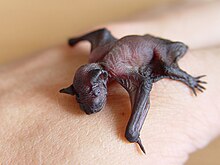Bats
| Bats | ||||||||||||
|---|---|---|---|---|---|---|---|---|---|---|---|---|
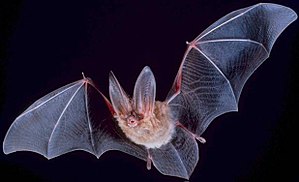
Townsend long-eared ( Corynorhinus townsendii ) |
||||||||||||
| Systematics | ||||||||||||
|
||||||||||||
| Scientific name | ||||||||||||
| Chiroptera | ||||||||||||
| Blumenbach , 1779 |
The bats (Chiroptera), also known as flutter animals , are an order of mammals . With around 1100 species , a fifth of all mammal species, the bats are the most species-rich order within the mammals after the rodents . They acquired the ability to fly flapping as the genetically youngest vertebrate group - after the extinct pterosaurs and birds .
distribution
Bats are found almost all over the world, they can be found on all continents of the world with the exception of Antarctica . They are also absent in other polar regions and on remote islands. On some islands (e.g. New Zealand ), however, they were the only mammals until the arrival of humans. The greatest biodiversity is in the tropics. The smooth nose free tails (Emballonuridae), the free-tailed bat (Molossidae) and Myotis bats (Vespertilionidae) are found in all warm regions of the earth. Eleven families live only in the Old World (including the fruit bats (Pteropodidae)), six only in the New World , e.g. B. the leaf noses (Phyllostomidae). The smooth-nosed bats and some horseshoe bats (Rhinolophidae) have also colonized cool temperate climates. The mouse ears ( Myotis ), which are found almost worldwide, have the largest distribution area of all land-living mammals.
features
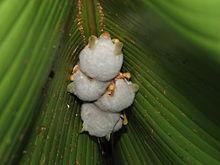
Shape, morphology as well as the structure and performance of the organs are determined by the requirements of active flight and lead to numerous analogies with birds. All bats can fly, a secondary loss of the ability to fly, as in some birds, does not occur. The wings were formed by redesigning the front extremities. The humerus and especially the finger rays II to V are greatly elongated. The focus is on the chest area, where the spine is bent up to make room for the strong heart and large lungs. The strong wing muscles attach to a frequently existing sternum crest. The hip joints are turned to the side so that the legs are on the side. Nevertheless, some species, e.g. B. the New Zealand bats , skilfully walk on the ground. The foot claws are sharp and curved and are used to hold on in the resting position.
With the exception of the flight skin, the bats are mostly covered with a thick fur. Most are brown, gray, or blackish. Some species are also reddish or yellowish in color. A pure white fur also occurs. Some species are streaked or spotty. The wings can also be patterned. In some species they are more or less transparent. Flying foxes often have a contrasting color in the neck and shoulder area ("collar formations"). Different colors between the sexes are rare. Bats have glandular skin and, in many cases, large accumulations of glands on the face (with leaf noses, smooth noses and horseshoe bats) or on the neck and shoulders (with leaf noses and flying foxes). The glands are often more pronounced in males than in females. The secretions secreted by the glands are used for communication via the sense of smell .
The flight membrane consists of two layers of skin and extends from the wrists to the ankles. Additional membranes extend from the wrists to the shoulders and between the legs. The latter is called uropatagium (tail fly skin ), it binds the tail - if available - and is often used to net the prey. The thumb is short - it is only missing in the stump thumbs (Furipteridae) - and has a claw, the other four fingers are greatly elongated and stretch the skin. While fruit bats usually also have a claw on the second finger, this is missing in bats. A thorn on the ankle, called a calcar , is used to stretch the tail skin. In contrast to most other mammals, the back legs of the bats are directed backwards, they end in five clawed toes.
The size of the bats varies considerably, with the pig- nosed bat ( Craseonycteris thonglongyai ) at 3 cm in length and 2 grams in weight being one of the smallest mammals, while the Kalong flying fox ( Pteropus vampyrus ) and the golden-crowned flying fox ( Acerodon jubatus ) have a wingspan of up to 1.7 meters and a weight of 1.2 to 1.5 kilograms.
Head and skull
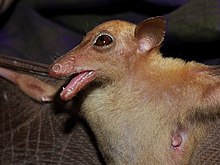
The easiest way to distinguish bats is by their head. Many families are characterized by typical nasal leaves , wrinkles, furrows, warts or ear shapes. The family of the New World Leaf Noses (Phyllostomidae) shows a particularly high variability with regard to the shape of the skull. At the ear entrance there is often a pointed or blunt ear cover, the tragus . The bats' ear capsules are large, the eardrum and ossicles are small. The cochlea is often only loosely connected to the skull for acoustic isolation from the sound-generating organs . Flying foxes have large, powerful eyes, while those of bats are rather small. In adaptation to flying, the skull bones are light and thin. The shape of the skull varies depending on the diet. In nectar-drinking species, the skulls are long and narrow. This is particularly pronounced in the banana bat ( Musonycteris harrisoni ). Fruits or insectivorous species have shorter and wider skulls, e.g. B. the old man's face ( Centurio senex ), a frugivorous species. The small bamboo bat ( Tylonycteris pachypus ) and the discus-footed bat ( Eudiscopus denticulus ), which use hollow bamboo stalks as shelter, have very flat skulls in order to be able to pass through the narrow crevices that provide access to their sleeping quarters.
Dentition
Due to the variety of diets, a great variability of the teeth has developed and around 50 different tooth formulas can be distinguished. The original tooth formula of the Chiroptera is I 2/3, C 1/1, P 3/3, M 3/3 = 38. Bats often only have two incisors in the upper jaw, a short snout is in most cases with a smaller number of Premolars . The molars of the insectivorous, piscivorous and carnivorous species are sharp-edged and can cut up animal food. Fruit-eating bats often have a strong palate and a strong tongue and only squeeze the juice out of the pulp with both and their flat-crowned molars, while they spit out the fibrous remains. The long and dagger-like canine teeth of these animals are used to hold the fruit. In the species that feed on nectar, the molars are separated by gaps and have long, narrow crowns. The blood-nourishing common vampire ( Desmodus rotundus ) has teeth that are greatly reduced and only consist of twenty teeth. The upper premolars and molars are regressed, the upper incisors and canines are enlarged and have knife-like, sharp edges to cut through the skin of the prey.
Way of life
Most bats - with the exception of some fruit bats - are nocturnal animals that sleep in hiding during the day. They usually hang upside down on their feet, which enables a quick escape by simply dropping them in case of danger. You don't need force to cling on because the bat's weight will bend the claws. Therefore, even dead bats do not fall down. Most bats orientate themselves during flight by echolocation: With their mouth or nose they repel sounds that are in the ultrasound range, i.e. beyond the human hearing limit. Some species, especially the large-leaf noses (Megadermatidae) and the leaf noses (Phyllostomidae) have conspicuous growths on the noses, so-called nasal leaves, which serve to amplify these sounds. The ears are well developed and often very large, a tragus (ear cover) is present in many species and serves to better receive the signals sent back. In contrast, fruit bats, with the exception of rosette bats, do not use echolocation. Bats are not blind, but have well-developed eyes, even if - as in many nocturnal animals - the rods in the retina predominate. Flying foxes in particular have a well-developed sense of sight. The sense of smell is also well developed in most species.
Bats spend the day in caves, crevices, tree hollows or in man-made dwellings such as mines, ruins and buildings; Flying foxes are more likely to sleep on trees than bats. Many species live in large colonies, often made up of thousands of animals, while others are solitary.
They often hibernate in cooler regions or move to warmer regions during winter. Their metabolism also decreases to a greater extent than in other mammals during daytime sleep.
food
Bats eat a wide variety of foods depending on the species. You can divide them into several groups based on your preferred food, but this division is not systematic:
- Insects: About 75% of the species are insectivores (more than 800 species), including most of the bats found in Europe. They feed mainly on beetles and butterflies.
- Fruits: The fruit-eating species include, for example, the majority of the fruit bats and the fruit vampires of America. Fruit-eating bats only live in the tropics and subtropics, where fruit is abundant all year round. They make up about a quarter of all bat species.
- Pollen and nectar: This type of food is preferred by the long-tongue bat and the flower bats . These bats are small, have long snouts and tongues, and play an important role in pollinating plants. The group is small and accounts for about 5% of the bat species.
- Vertebrates: Some species (approx. 2%) feed on birds, frogs, lizards and small mammals such as rodents or other bats. These include, for example, several representatives of the lance noses or the large-leaf noses . Some species, such as the rabbit mouths (Noctilionidae) specialize in fish.
- Blood: The diet with blood from vertebrates occurs exclusively in the three species of vampire bats (Desmodontinae) of Central and South America.
Fruit-eating bats or bats that feed on nectar or pollen only occur in the warm zones of the earth. In the Old World it is the fruit bats, in the New World mainly species from the family of leaf noses (Phyllostomidae). Some fruit-eating bats also eat insects. Numerous plant species have developed various adaptations to attract bats as pollinators. These include exposed and strong, strongly smelling flowers with a lot of nectar and pollen and blooming at night ( chiropterophilia ).
Reproduction
In general, bats are characterized by a low rate of reproduction. In most cases only one young is born and the bats of temperate climates give birth only once a year. Several births per year can only occur in tropical regions. In most species, the females have two teats in the chest area. Of the European species, only the two-colored bat ( Vespertilio murinus ) has two pairs of teats. The females of the large-leaf noses, horseshoe noses and slit noses each have a pair of sticky teats in the groin area, which are only used to hold the young and do not lactate. Another characteristic of the bats is the delayed fertilization: The semen of the males can be kept in the reproductive tract of the females for several months, only when the weather is favorable the fetus begins to grow in the uterus . The births take place in a normal, hanging rest position or in a horizontal or upright position with the head or rump first. The females of groups of fruit bats can help each other with births. The newborns are mostly blind and not very hairy, but they are already quite large. Their birth weight is 20 to 30% of the weight of an adult specimen. They generally develop quite quickly after birth, and sexual maturity is often reached quickly after development is complete. Smooth nosed pups are suckled for 3 to 8 weeks and become sexually mature at 3 to 18 months of age. It takes 5 to 24 months for the juveniles of the fruit bats to become sexually mature. To compensate for the low reproductive rate, bats are very long-lived compared to other small mammals, some animals, etc. a. the fruit bats can live up to 20 years old, others over 30 years old, the great bearded bat ( Myotis brandtii ) can even live to be more than 40 years old.
Systematics
The bats were introduced as a scientific taxon in 1779 by the German anatomist and zoologist Johann Friedrich Blumenbach . The scientific name Chiroptera is derived from the Greek χείρ cheir , 'hand', and πτερόν pteron , 'wing', which means “hand winged”.
It is difficult to determine the position of bats in the mammalian family tree. In the past they were sometimes considered to be close relatives of the giant gliders and primates , but more recent research results put them together with the cetartiodactyla ( even-toed ungulates and whales ), odd-toed ungulates (Perissodactyla) and predators (Carnivora) in the superordinate order of the Laurasiatheria .
| External classification of the bats | |||||||||||||||||||||||||||||||||
|---|---|---|---|---|---|---|---|---|---|---|---|---|---|---|---|---|---|---|---|---|---|---|---|---|---|---|---|---|---|---|---|---|---|
|
Traditionally, which were within the bats flying foxes (Megachiroptera) and the bats (Microchiroptera) distinguished. Current molecular studies show, however, that the horseshoe bat-like (Rhinolophoidea), a group of bats, are more closely related to the flying foxes than to the other bats. The bats thereby become a paraphyletic group, which is undesirable in a modern system where all descendants of a common ancestor should belong to a ( monophyletic ) group. The fruit bats are likely descended from echolocating ancestors, but over the course of evolution they have replaced this ability with better night vision. The bats are therefore divided into the Yinpterochiroptera or Pteropodiformes, that is the clade of the flying foxes and horseshoe bat-like, and the Yangochiroptera or Vespertilioniformes, the clade of the other bats.
Both clades have the rank of subordination. There are five superfamilies and over 20 families.
- Suborder Yangochiroptera
- Superfamily Emballonuroidea
- Smooth-nosed cantails (Emballonuridae)
- Slit noses (Nycteridae)
- Superfamily hare-mouthed (Noctilionoidea)
- Stump thumb (Furipteridae)
- Chin-leaf bats (Mormoopidae)
- New Zealand bats (Mystacinidae)
- Malagasy sticky disc bats (Myzopodidae)
- Rabbit mouths (Noctilionidae)
- Leaf noses (Phyllostomidae)
- American disc bats (Thyropteridae)
- Superfamily smooth-nosed (Vespertilionoidea)
- Cistugidae
- Long-winged bats (Miniopteridae)
- Bulldog bats (Molossidae)
- Funnel ears (Natalidae)
- Smooth-nosed (Vespertilionidae)
- Superfamily Emballonuroidea
- Suborder Yinpterochiroptera
- Superfamily Pteropodoidea
- Fruit bats (Pteropodidae)
- Superfamily horseshoe bat (Rhinolophoidea)
- Pig- nosed bat (Craseonycteridae)
- Round-leaf noses (Hipposideridae)
- Large-leaf noses (Megadermatidae)
- Horseshoe bat (Rhinolophidae)
- Rhinonycteridae
- Mouse-tailed bats (Rhinopomatidae)
- Superfamily Pteropodoidea
| Internal systematics of the bats | |||||||||||||||||||||||||||||||||||||||||||||||||||||||||||||||||||||||||||||||||||||||||||||||||||
|---|---|---|---|---|---|---|---|---|---|---|---|---|---|---|---|---|---|---|---|---|---|---|---|---|---|---|---|---|---|---|---|---|---|---|---|---|---|---|---|---|---|---|---|---|---|---|---|---|---|---|---|---|---|---|---|---|---|---|---|---|---|---|---|---|---|---|---|---|---|---|---|---|---|---|---|---|---|---|---|---|---|---|---|---|---|---|---|---|---|---|---|---|---|---|---|---|---|---|---|
|
Tribal history
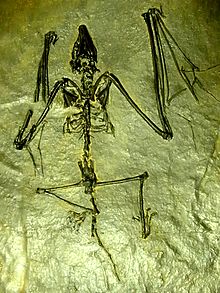

The history of the development of the bats is only sparsely documented by fossil finds. In contrast to other mammalian taxa that are difficult to classify, such as whales, the fossil record has so far provided no evidence of transitional forms . As a result, the conditions that led to the evolution of flapping flight in bats are unclear. John Speakman, professor of zoology at the University of Aberdeen , reconstructs the evolution of the bats in such a way that these animals were initially diurnal and only under the pressure of birds of prey increasingly shifted to catching prey at night. At the same time, echolocation developed.
Bats evidently achieved worldwide distribution as early as the Eocene - finds of relatively well developed bats in Europe, North America and Australia have been documented from this epoch. The oldest genera found so far include Onychonycteris and Icaronycteris from the early Eocene of the Green River Formation Wyoming as well as Archaeonycteris , Palaeochiropteryx , Hassianycteris and Tachypteron from the middle Eocene of the Messel Pit in Germany. These early representatives are already very similar in their physique to today's bats, differences exist only in details such as the presence of finger claws and a long, free tail (which is also found in today's mouse- tailed bats ). Onychonycteris had even shorter forearm bones, longer hind legs than modern bats and claws on all five fingers. They probably couldn't fly as well as today's bats. Their cochlea was relatively small, comparable to that of today's non-echolocating fruit bats. This shows that the bat's echolocation system probably only developed after the development of active, controllable fluttering flight. Other bats from the Eocene, such as Icaronycteris and Tachypteron, may already have been able to echo . Since fossil records are missing for many families, little is known about the development history of the individual bat groups.
Danger
Many bat species are threatened. The reasons for this are mostly the loss of living space, both in the tropics through forest clearing and in industrialized countries through the use of pesticides and pesticides and the sealing of sleeping places through renovation of old buildings. According to the IUCN , 12 species are extinct, and 75 more are considered threatened or critically endangered.
The natural enemies of the bats are the owls, in addition, they are preyed on by birds of prey, snakes, cats and carnivorous bat species. Its numerous parasites include the blood-sucking, mostly wingless bat flies ( Nycteribiidae and Streblidae ).
Bats are persecuted due to the transmission of disease to humans by bat-specific viruses. Bats are hunted, especially during the global COVID-19 pandemic . Researchers speak out against the persecution of bats and blame false information and human psychology for it. Since media coverage has cast a bad light on bats, science wants to raise awareness about bats.

use
In Indonesia , Thailand , Vietnam , Guam and in other Asian countries and cultures in the Pacific region, bats are used as food .
literature
- Erwin Kulzer: Chiroptera, bats (fruit bats and bats). In: Wilfried Westheide & Reinhard Rieger : Special Zoology Part 2: Vertebrae and Skull Animals. 2nd edition, Spektrum Akademischer Verlag Heidelberg, Berlin 2010, ISBN 978-3-8274-2039-8 , pp. 595-603.
Individual evidence
- ↑ a b c d e f Westheide & Rieger, page 595.
- ↑ a b Westheide & Rieger, page 596.
- ^ Westheide & Rieger, page 597.
- ↑ a b c Westheide & Rieger, page 599.
- ↑ a b Westheide & Rieger, page 603.
- ^ Johann Friedrich Blumenbach: Handbook of natural history. 1st edition, 2 parts, Johann Christian Dieterich, Göttingen 1779–1780, pages 74–76 ( online ).
- ↑ Maureen A. O'Leary, Jonathan I. Bloch, John J. Flynn, Timothy J. Gaudin, Andres Giallombardo, Norberto P. Giannini, Suzann L. Goldberg, Brian P. Kraatz, Zhe-Xi Luo, Jin Meng, Xijun Ni, Michael J. Novacek, Fernando A. Perini, Zachary S. Randall, Guillermo W. Rougier, Eric J. Sargis, Mary T. Silcox, Nancy B. Simmons, Michelle Spaulding, Paúl M. Velazco, Marcelo Weksler, John R Wible, Andrea L. Cirranello: The Placental Mammal Ancestor and the Post-K-Pg Radiation of Placentals . In: Science . tape 339 , no. 6120 , 2013, p. 662-667 , doi : 10.1126 / science.1229237 , PMID 23393258 .
- ↑ Steven R. Hoofer, Serena A. Reeder, Eric W. Hansen, Ronald A. Van Den Bussche: Molecular Phylogenetics and Taxonomic Review of Noctilionoid and Vespertilionoid Bats (Chiroptera: Yangochiroptera) . In: Journal of Mammalogy . tape 84 , no. 3 , 2003, ISSN 0022-2372 , p. 809-821 , doi : 10.1644 / BWG-034 .
- ↑ a b c James M. Hutcheon, John AW Kirsch. A moveable face: deconstructing the Microchiroptera and a new classification of extant bats . Acta Chiropterologica 8 (1): 1-10. 2006 doi : 10.3161 / 1733-5329 (2006) 8 [1: AMFDTM] 2.0.CO; 2
- ^ Cassandra M. Miller-Butterworth, William J. Murphy, Stephen J. O'Brien, David S. Jacobs, Mark S. Springer, Emma C. Teeling: A Family Matter: Conclusive Resolution of the Taxonomic Position of the Long-Fingered Bats, Miniopterus . In: Molecular Biology and Evolution . tape 24 , no. 7 , 2007, ISSN 0737-4038 , p. 1553-1561 , doi : 10.1093 / molbev / msm076 .
- ↑ Emma C. Teeling, Mark Scally, Diana J. Kao, Michael L. Romagnoli, Mark S. Springer, Michael J. Stanhope: Molecular evidence regarding the origin of echolocation and flight in bats . In: Nature . tape 403 , no. 6766 , 2000, pp. 188-192 , doi : 10.1038 / 35003188 .
- ↑ Emma C. Teeling, Ole Madsen, Ronald A. Van Den Bussche, Wilfried W. de Jong, Michael J. Stanhope, Mark S. Springer: Microbat paraphyly and the convergent evolution of a key innovation in Old World rhinolophoid microbats . In: Proceedings of the National Academy of Sciences . tape 99 , no. 3 , 2002, ISSN 0027-8424 , p. 1431-1436 , doi : 10.1073 / pnas.022477199 , PMID 11805285 .
- ↑ Emma C. Teeling, Ole Madsen, William J. Murphy, Mark S. Springer, Stephen J. O'Brien: Nuclear gene sequences confirm an ancient link between New Zealand's short-tailed bat and South American noctilionoid bats . In: Molecular Phylogenetics and Evolution . tape 28 , no. 2 , 2003, ISSN 1055-7903 , p. 308-319 , doi : 10.1016 / S1055-7903 (03) 00117-9 .
- ^ A b Emma C. Teeling, Mark S. Springer, Ole Madsen, Paul Bates, Stephen J. O'Brien, William J. Murphy: A Molecular Phylogeny for Bats Illuminates Biogeography and the Fossil Record . In: Science . tape 307 , no. 5709 , 2005, p. 580-584 , doi : 10.1126 / science.1105113 , PMID 15681385 ( researchgate.net [PDF]).
- ↑ EC Teeling, S. Dool, MS Springer: Phylogenies, fossils and functional genes: the evolution of echolocation in bats. In: GF Gunnell, NB Simmons (Ed.): Evolutionary History of Bats: Fossils, Molecules and Morphology. Cambridge University Press, Cambridge 2012, pp. 1-22.
- ^ RA Van Den Bussche, SR Hoofer: Phylogenetic relationships among recent chiropteran families and the importance of choosing appropriate out-group taxa. Journal of Mammalogy. 85, No. 2, 2004, pp. 321-330. doi : 10.1644 / 1545-1542 (2004) 085 <0321: PRARCF> 2.0.CO; 2
- ↑ Mark S. Springer, Emma C. Teeling, Ole Madsen, Michael J. Stanhope, Wilfried W. de Jong: Integrated fossil and molecular data reconstruct bat echolocation . In: Proceedings of the National Academy of Sciences . tape 98 , no. 11 , 2001, p. 6241-6246 , doi : 10.1073 / pnas.111551998 , PMID 11353869 .
- ^ KF Koopman: A synopsis of the families of bats. Part VII. Bat Research News 25, 1985, pp. 25-27.
- ↑ Chiroptera Blumenbach, 1779 at ITIS
- ^ John R. Speakman: The evolution of flight and echolocation in bats: another leap in the dark. In: Mammal Rev. 31, No. 2, 2001, pp. 111-130, doi: 10.1046 / j.1365-2907.2001.00082.x .
- ^ Nancy B. Simmons, Kevin L. Seymour, Jörg Habersetzer, Gregg F. Gunnell: Primitive Early Eocene bat from Wyoming and the evolution of flight and echolocation . In: Nature . tape 451 , no. 7180 , 2008, p. 818-821 , doi : 10.1038 / nature06549 .
- ↑ Nancy B. Simmons, Jonathan H. Geisler: Phylogenetic relationships of Icaronycteris, Archeonycteris, Hassianycteris and Palaeochiropteryx to extant bat lineages, with comments on the evolution of echolocation and foraging strategies in microchiroptera. In: Bulletin of the American Museum of Natural History. New York NY 235, ISSN 0003-0090 , pp. 1-82 ( digitallibrary.amnh.org ).
- ↑ Juliette Irmer: Hunting bats and fruit bats: The scapegoats of the pandemic pay with their lives. In: Neue Zürcher Zeitung . April 4, 2020, accessed June 19, 2020 .
- ↑ Douglas MacFarlane, Ricardo Rocha: Guidelines for communicating about bats to prevent persecution in the time of COVID-19 . In: Biological Conservation . tape 248 , 2020, doi : 10.1016 / j.biocon.2020.108650 .




